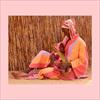
Ethiopia
AFRICA: Need to focus on maternal, child health - top AU official
ETHIOPIA: ETHIOPIA: Zahara Abdu, "Five years ago we had 50 cows, now we have nothing"
Ethiopia starts coffee exchange
ETHIOPIA: Children at greatest risk among Afar’s drought-displaced
ETHIOPIA: New initiative against FGM/C
Southern Region to Reclaim Undeveloped Land
National name: Ityop'iya Federalawi Demokrasiyawi Ripeblik
Geography
Capital: Addis Ababa
Major Towns: Bahir Dar, Jimma, Moyale, Dire Dawa, Werder
Location (geographical coordinates/latitude and longitude): 9°01'N, 38°44'E
Time Zone: EAT (UTC+3)
Size (Land and Sea): 1,127,127 sq km
Borders with Djibouti 349 km, Eritrea 912 km, Kenya 861 km, Somalia 1,600 km, Sudan 1,606 km
Elevation extremes: Lowest point: Denakil Depression -125 m; Highest point: Ras Dejen 4,620 m
Politics
Head of State: President: Girma Woldegiorgis (2001), Prime Minister: Meles Zenawi (1995)
Form of Government: Federal Republic
Currency: Birr (ETB)
Industry
Main industries (income) food processing, beverages, textiles, leather, chemicals, metals processing, cement
Natural resources: small reserves of gold, platinum, copper, potash, natural gas, hydropower
Agriculture: cereals, pulses, coffee, oilseed, cotton, sugarcane, potatoes, qat, cut flowers; hides, cattle, sheep, goats; fish
Population and People
Population: 76,511,887
Population density per sq mi: 177
Growth rate: 2.3%
Birth rate: 37.39 births/1,000 population (2007 est.)
Total fertility rate: 5.1 children born/woman (2007 est.)
Infant mortality rate: 91.9/1000
Religion: Christian 60.8% (Orthodox 50.6%, Protestant 10.2%), Muslim 32.8%, traditional 4.6%, other 1.8% (1994 census)
Languages: Amarigna 32.7%, Oromigna 31.6%, Tigrigna 6.1%, Somaligna 6%, Guaragigna 3.5%, Sidamigna 3.5%, Hadiyigna 1.7%, other 14.8%, English (major foreign language taught in schools) (1994 census)
Ethnic groups / Tribes: Oromo 32.1%, Amara 30.1%, Tigraway 6.2%, Somalie 5.9%, Guragie 4.3%, Sidama 3.5%, Welaita 2.4%, other 15.4% (1994 census)
Average age: 0-14 years: 43.4% (male 16,657,155/female 16,553,812); 15-64 years: 53.8% (male 20,558,026/female 20,639,076); 65 years and over: 2.7% (male 953,832/female 1,149,986) (2007 est.)
Life expectancy: 49.2
Literacy (definition: age 15 and over can read and write): Total population: 42.7%; male: 50.3%; female: 35.1% (2003 est.)
- Unique among African countries, the ancient Ethiopian monarchy maintained its freedom from colonial rule with the exception of the 1936-41 Italian occupation during World War II
- Independency oldest independent country in Africa and one of the oldest in the world - at least 2,000 years
- The only country in Africa never to have been fully colonised (with the exception of a five-year occupation by Mussolini's Italy)
- Famous Haile Selassie, who became emperor in 1930 and ruled until the military coup of 1974
- It claim some of the highest and most stunning places on the African continent
- City of Aksum, once the site of a great civilisation with underground tombs (most still undiscovered). The ancient royal capital of the earliest Ethiopian kingdom has carved granite obelisks
- What Petra is for the Middle East is Lalibela for Ethiopia: rock-hewn churches. At an altitude of 2630m (8629ft), Lalibela's 11 churches are cut straight from the bedrock, so their roofs are at ground level. They were built within one century; some, according to legend, with the help of angels. The churches have been kept alive by generations of priests who guard their treasures of ornamented crosses, illuminated Bibles and illustrated manuscripts. Bete Medhane Alem is believed to be the largest monolithic church in the world
- Simien Mountains Park with large variety of wildlife
- Danakil Depression, with its sulphur fumaroles and lunar-like landscape
- 14 major wildlife reserves
- Walking safaris or safaris on mule
- The moorlands of the Bale Plateau
- Caves of Dire Dawa with evidence of prehistoric habitation
- Addis Ababa’s mercato is one of the largest markets in Africa
- Lake Langano with great swimming and a resort offering windsurfing and waterskiing
- Natural springs in the Awash National Park and at Sodere Filwoha create pools highly valued for their therapeutic purposes
- Lake Tana, Ethiopia's largest lake, contains 37 islands complete with numerous monasteries
- Addis Ababa offers National Museum, the Menelik Palace, the Jubilee Palace, the Meskal (Revolution) Square, St George's Cathedral and the Ethnology Museum
- Blue Nile Falls (also called Tissisat), one of the most spectacular
- Mysterious atmosphere of Gondar which was the capital from 1632 to 1855 and is today known for its many ruins
- Bizarre spectacle in Harar: local men attract wild hyenas to the city at dusk to feed them. The place is also a famous Muslim walled city with 99 mosques and the centre for the coffee trade
- Africa's second-most populous nation
- It has yielded some of the oldest traces of humanity, making it an important area in the history of human evolution. Recent studies claim that the vicinity of present-day Addis Ababa was the point from which human beings migrated around the world.
- Second-oldest country to become officially Christian, after Armenia
- It was one of the fifty-one original members of the United Nations (UN)
- Became a member of the League of Nations in 1923
- Headquarters of the African Union of which Ethiopia was the principal founder is in Addis Ababa
- Fossilized remains of the earliest ancestors to the human species, discovered in Ethiopia, have been assigned dates as long ago as 5.9 million years.
 Text Area - Text Area
Text Area - Text Area Content List - Ethiopia News
Content List - Ethiopia News
 Map - Ethiopia Map
Map - Ethiopia Map